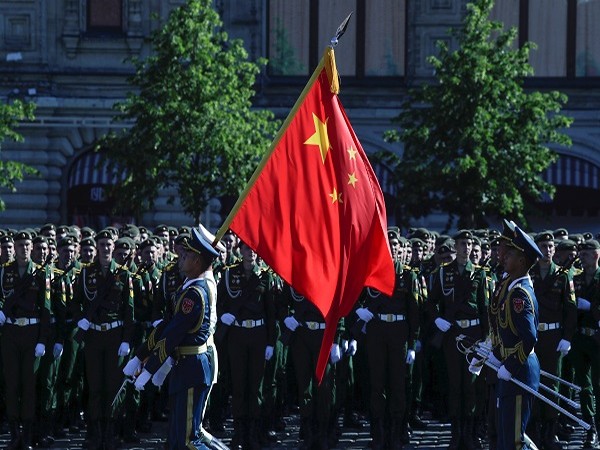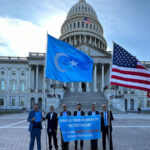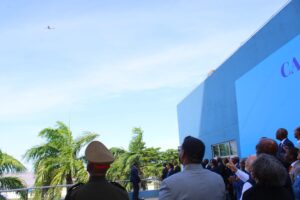
Soldiers of China's People's Liberation Army carry a state flag before the Victory Day Parade in Red Square in Moscow, Russia, June 24, 2020. The military parade, marking the 75th anniversary of the victory over Nazi Germany in World War Two, was scheduled for May 9 but postponed due to the outbreak of the coronavirus disease (COVID-19). Pavel Golovkin/Pool via REUTERS - RC2IFH9BG5M1
Hong Kong, January 17 (ANI): Many are alarmed by China‘s growing military ambitions, with heated tensions in places like the East China Sea, South China Sea, near Taiwan and the Indian border. The People’s Liberation Army (PLA) has benefitted greatly from a deluge of cash and copious amounts of cutting-edge equipment being added to its inventory. Last year was full of disconcerting surprises, including the discovery of massive silo fields for intercontinental ballistic missiles, and the testing of a fractional orbital bombardment system. However, more surprises await in 2022.
Kurt Campbell, the US National Security Council Coordinator for the Indo-Pacific, warned last week of a “strategic surprise” in the region. He told the Center for Strategic and International Studies in Washington DC: “If you look and if you ask me, where are the places where we are most likely to see certain kinds of strategic surprise – basing or certain kinds of agreements or arrangements – it may well be in the Pacific.” The American official said the issue was the one he was “most concerned about over the next year or two”. Expressing urgency, Campbell said, “And we have a very short amount of time, working with partners like Australia, like New Zealand, like Japan, like France, who have an interest in the Pacific, to step up our game across the board.”
Campbell did not elaborate on what he meant by “strategic surprise”, but in context his comments hint that China may be brewing up a significant basing agreement somewhere in the region. It could be that he was hinting at a specific development of which he is aware, or perhaps that he expects Beijing to throw its economic and military weight round in genuinely unexpected ways.
However, such comments do not bode well. The USA should have been preparing for China‘s rise for the past decade or two. The American intelligence community should be on top of how China is muscling in on other countries. Unfortunately, the USA has dropped the ball by ignoring friends and refusing opportunities in the Asia-Pacific region. Indeed, Campbell admitted that the USA has not done enough to assist countries in the Indo-Pacific region despite “enormous moral, strategic, historical interests”.
When Donald Trump pulled out of the trade deal known as the Comprehensive and Progressive Agreement for Trans-Pacific Partnership, disappointment in the USA was palpable. In its place, many smaller Pacific countries list China as their largest trading partner and have become dependent on this Asian giant. China is sending six members of its police force, plus anti-riot equipment, to the Solomon Islands to “equip and train” local police in the wake of destructive riots in the capital Honiara.
Other concerns center upon Vanuatu and Kiribati. Regarding the latter, last year it emerged that China had drawn up plans to upgrade an airstrip and bridge on the island of Kanton. The Kiribati authorities insisted the Chinese plan was a non-military one that would improve transport links and tourism. This location is approximately 3,000km southwest of the strategically important state of Hawaii. China has a major presence all across the Pacific, whether it be diplomatic, commercial, infrastructure or citizens in residence. China‘s hooks are already in the region, almost enabling China to leapfrog American defenses along the so-called First Island Chain.
It seems only a matter of time before Beijing creates some kind of military presence in the Pacific, and this will make it harder for the US military to operate. It would be like having the enemy in your rear. Indeed, the US Marine Corps (USMC) has totally restructured for a potential fight against China in the Pacific, creating smaller, dispersed units that can fight independently from islands but with interlocking fields of fire with anti-ship missiles and long-range rockets. The USMC has also given away all its tanks, bridging equipment and other assets to support this warfighting plan. However, if China can operate freely from multiple Pacific islands in the rear of US forces, the plan will be a flop even before it starts. “Dual-use” (commercial with the potential to support military) Chinese bases are not without challenges. The PLA is not particularly strong in long-range logistics and command and control, but China might also be interested in denying access to the USA and its allies.
Furthermore, quite apart from war scenarios, dispersed outposts would allow the PLA to refuel ships and to resupply in peacetime. Beijing’s vicious rhetoric about AUKUS shows that this new-founded Australia-UK-USA alliance rankles. Any time that regional countries group together causes China consternation, whether it be Australia, India, Japan or some other.
Interestingly, at the end of December 2021, the Philippines issued a notice of award to India for three batteries’ worth of BrahMos supersonic anti-ship cruise missiles. This acquisition has been in the works for several years, and reflects Philippine mistrust of China‘s intentions in the South China Sea. If they are sited somewhere like Palawan, they would control a large swathe of territory extending towards the Spratly Islands.
Beijing did well in manipulating President Rodrigo Duterte into maintaining a pro-China stance, even if the Armed Forces of the Philippines never subscribed to Duterte’s misplaced optimism. The fact that Manila went ahead with this acquisition reflects the level of mistrust towards China.
The South China Sea is certainly a place where China could unleash a “strategic surprise” too, whether it be constructing a military installation on Scarborough Shoal or fomenting some other kind of trouble. In 2021, the USA was joined by other countries like Canada, France, Germany and the UK in conducting naval passages through places like the South China Sea or Taiwan Strait. They are perfectly entitled to do so under international law, but Beijing kicks up a stink every time.
In 2020 the US Navy conducted eight freedom of navigation operations (FONOPS) in the South China Sea, and 13 passages through the Taiwan Strait. This compares with five reported FONOPs and 11 passages last year.
The USA has been ramping up diplomatic pressure on China in other ways too. This month, the US State Department released a new report entitled “Limits in the Seas”, and subtitled People’s Republic of China: Maritime Claims in the South China Sea.
Following the 2016 ruling by the Permanent Court of Arbitration against China‘s exorbitant territorial claims in the South China Sea, there have been few government-backed publications delineating the error of Beijing’s stance that runs counter to international law. This new report goes some way to closing that gap. Coming with the backing of the US government, it is a weighty document. The whole premise of the report is to measure Chinese claims in the South China Sea against the regulations of the United Nations Convention on the Law of the Sea (UNCLOS). Given that China itself ratified UNCLOS in 1996, Beijing should be following its rules instead of brazenly trampling on the international law it voluntarily signed up to.
The report finds four types of Chinese claims that are “unlawful” and incompatible with UNCLOS. They are: 1. Sovereignty claims to reefs and other features that lie entirely underwater; 2. Drawing straight baselines around very spread-out groups of islands; 3. Claiming to own everything within those baselines; and 4. Unspecified “historic rights” that go beyond UNCLOS.
Indeed, the report unequivocally states, “No provision of the convention contains the term ‘historic rights’, nor is there a uniform understanding of what, specifically, the term means as a matter of international law.” The report noted, “The advent of exclusive jurisdiction of a coastal state over fisheries within 200 nautical miles of its coast overrides the prior usage and rights of other states in that area.” In short, the authority of UNCLOS trumps whatever went before. Thus, China‘s assertion of authority over places like the Paracel and Spratly Islands, no matter that the China Geographical Names Committee relabels them with “official” Chinese names, has no basis in law.
Nor does the insistence of the Chinese Society for International Law that “sovereignty over an archipelago as a unit naturally covers sovereignty over each and every component part” hold any water. An acknowledged expert on South China Sea politics is Bill Hayton, associate fellow with the Asia-Pacific Programme at Chatham House. He warned, “This is very bad for international law,” when one country is determined to break accepted rules for the sake of illegally grabbing territory.
Hayton further explained, “The original reason why China claimed underwater features as territory is because its officials didn’t have a clue what was what. They were motivated by nationalism, not measurement.” As an example of Chinese ignorance, it lays claim to Zhongsha Qundao, which does not even exist as islands. Apart from Scarborough Shoal, all Chinese-claimed features are underwater, even though Chinese officials continue to claim they are not. This makes them “look very silly,” Hayton remarked. In 1996, China asserted baselines (the lines that divide a territorial sea and internal waters around a landmass) around the Parcel Islands. However, this is incompatible with UNCLOS rules too.
Additionally, since China‘s claimed features in the Spratly Islands all lie underwater, then it does not own any territory there. Incidentally, building on an underwater feature to turn it into a military installation does not alter its status in the eyes of UNCLOS. For these reasons, Beijing’s hypothetical straight baselines around all Spratly features are meaningless.
What is more, Article 47 in UNCLOS defines the maximum ratio of water area to land area that may be enclosed within archipelagic baselines as 9:1. In actual fact, China‘s Parcel baselines are 37:1, and its hypothetical Spratly baselines are 950:1! Its claims are thus of ridiculous proportions.
China fails to provide specific information concerning its historic rights, with only the vague and ambiguous Nine-Dash Line indicating what China might or might not be claiming. The State Department authors noted, “It is not known what specific rights are claimed by the PRC, or whether such rights are exclusive or, alternatively, rights that are shared with other coastal states. The PRC…has not provided a legal justification for such a claim.” Hayton added that this is so because such justifications do not exist!
Hayton added: “At this very moment, officials and lawyers in the PRC (and the ones China pays elsewhere) are trying to reverse engineer a logical ‘historical rights’ claim out of the legal nonsense spun by Professor Fu Kuen-chen” in the late 1980s and 1990s. Fu is a Chinese nationalist whose unfortunate concept of “historic rights” was incorporated into China‘s 1998 exclusive economic zone law.
What then was the conclusion of the 47-page report published by the US government? “The overall effect of these maritime claims is that the PRC unlawfully claims sovereignty or some form of exclusive jurisdiction over most of the South China Sea. These claims, especially considering their expansive geographic and substantive scope, gravely undermine the rule of law in the oceans and numerous universally recognized provisions of international law reflected in the convention.”
Hayton assessed the report as very good. “It’s clear, balanced, based on good evidence and well argued.” He predicted, “It will be a standard reference for future discussions on the legality of China‘s claims in the South China Sea.” Many countries have upheld implementation of UNCLOS and the 2016 Award on the South China Sea by the Permanent Court of Arbitration. However, Beijing has despised all such appeals to international law. In the meantime, all eyes should be on China in preparation for its “strategic surprise”. This will come in addition to revelations of new weapon types and ongoing threats to places like Taiwan throughout 2022. (ANI)


















